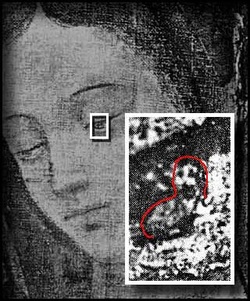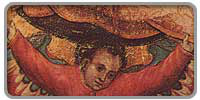Sacred Image of Our Lady of Guadalupe
The tilma or mantle of Juan Diego is imprinted with the Sacred Image of the Blessed Virgin. The tilma is hand woven from the coarse fibers of the Manguey cactus. This fabric has a life span of approximately 30 years. The imagine remains intact after more than 470 years. It is six and half feet long and forty inches wide. The image of Our Lady is four feet, eight inches high. The image is housed at the Basilica of Our Lady of Guadalupe in Mexico City.
The Scared Image is a pictograph. Every detail is symbolic and reveals part of the message the Blessed Virgin brought to the Indians through Juan Diego.
Mary appears as a beautiful young Indian maiden, her hands folded in an Indian manner of prayer. Her pale red dress is the color of an Aztec princess.
The main color or the tilma is turquoise. This color was reserved for the supreme god Omecihuatl. The color symbolizes the royalty of the gods and life and unity of everything that exists.
Her eyes are looking down. This is a position of humility and also reveals that she is not a god. Indian gods always looked straight ahead.
Her face shows compassion. She has the dark skin and hair like that of the Indians.
The main color or the tilma is turquoise. This color was reserved for the supreme god Omecihuatl. The color symbolizes the royalty of the gods and life and unity of everything that exists.
Her eyes are looking down. This is a position of humility and also reveals that she is not a god. Indian gods always looked straight ahead.
Her face shows compassion. She has the dark skin and hair like that of the Indians.
Mary stands in front of and hides the sun, but the rays still appear around her, signifying that she is greater than the sun god, the greatest of the native deities. Twelve rays of sun surround her.
She stands on the moon, supported by an angel with wings like an eagle. To an Aztec this signifies her superiority to the moon god. The angel is seen as an intermediary god bringing in a new era.
The stars on the mantle signified the beginning of a new civilization, or era is beginning. The stars are in the same configurations as the stars were on the morning of December 12, 1531.
Two crosses and a black maternity band are present on the image. Mary wore a black maternity band, signifying she was with child. This was a sign to the Indians that someone is yet to come. At the center of the picture is an Indian cross. On the brooch around her neck is a black Christian crosses, indicating that she is a believer and follower of Christ.
The image signifies Mary bringing her Son Christ to the New World through one of
The image signifies Mary bringing her Son Christ to the New World through one of
Scientific Evidence

Many scientific studies of the tilma have been conducted. The tilma remains just as vibrant as it was in 1531. Famous Mexican artists such as Miguel Cabrera (1695-1768) determined that it is impossible for the rough surface of the tilma to support any form of painting. One of the unusual characteristics of the tilma is that up close the features are unremarkable, but the tone and depth emerge beyond six or seven feet and the image becomes more radiant and photogenic.
The astonishing discovery that reflections of people in Mary’s eyes, perhaps Juan Diego and Bishop Zumarraga or the interpreter Juan Gonzalez, were confirmed by two scientists in 1956. This phenomenon is seen only with human eyes, not in a painting.
Philip C. Callahan, a research biophysicist at the University of Florida, undertook studies by infrared photography in May of 1979. The infrared photography determines that there are no brush strokes, over painting, sizing, or preliminary drawings on the tilma. He reported that large portions of the tilma were painted in one step. The work did show damage from the 1629 flood. He concluded that the original image on the tilma could not be the work of human hands.
The image is made of pigments that have not been identified by chemical analysis as coming from animals, vegetables or mineral dye.
Other studies dispute these supernatural claims. An investigation in 1556 stated Indian painter Marcos painted that image. 2002 claims reported that they identified the chemical dyes used to paint the tilman.
The questions behind the Sacred Image have had no effect on the devotion it inspires from millions of people.
The astonishing discovery that reflections of people in Mary’s eyes, perhaps Juan Diego and Bishop Zumarraga or the interpreter Juan Gonzalez, were confirmed by two scientists in 1956. This phenomenon is seen only with human eyes, not in a painting.
Philip C. Callahan, a research biophysicist at the University of Florida, undertook studies by infrared photography in May of 1979. The infrared photography determines that there are no brush strokes, over painting, sizing, or preliminary drawings on the tilma. He reported that large portions of the tilma were painted in one step. The work did show damage from the 1629 flood. He concluded that the original image on the tilma could not be the work of human hands.
The image is made of pigments that have not been identified by chemical analysis as coming from animals, vegetables or mineral dye.
Other studies dispute these supernatural claims. An investigation in 1556 stated Indian painter Marcos painted that image. 2002 claims reported that they identified the chemical dyes used to paint the tilman.
The questions behind the Sacred Image have had no effect on the devotion it inspires from millions of people.







